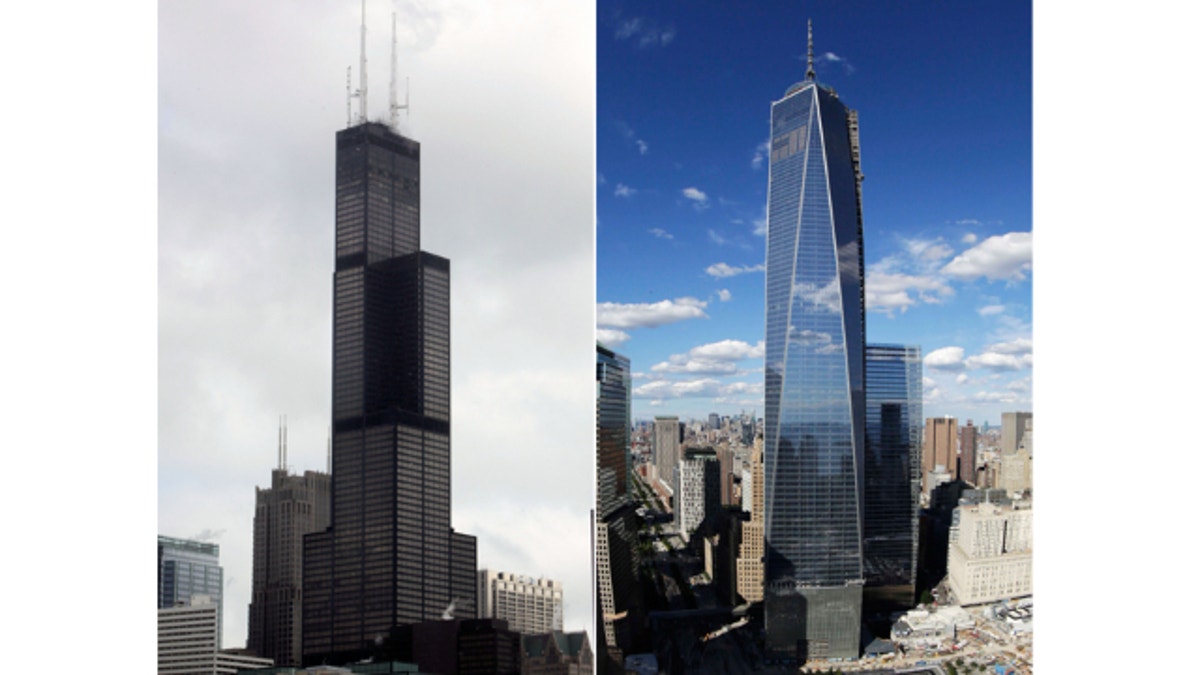
This combination made from file photos shows Willis Tower, formerly known as the Sears Tower, in Chicago on March 12, 2008, left, and One World Trade Center in New York on Sept. 5, 2013. (AP)
A committee of world building heights experts will announce next week whether a design change that affects the 408-foot needle on the new 1,776-foot World Trade Center tower disqualifies it from being counted as the nation's tallest skyscraper.
The nonprofit Council on Tall Buildings and Urban Habitat met to render a judgment behind closed doors in Chicago, where the world's first skyscraper appeared in 1884. Disqualification would deny the World Trade Center the title as the nation's tallest.
The main issue before the council is whether the tower's height should be measured to the top of the needle, which also serves as a broadcast antenna, or whether it should be measured to the roof of the building, at 1,368 feet. Under the council's current criteria, spires that are an integral part of a building's aesthetic design count; broadcast antennas that can be added and removed do not.
The designers of 1 World Trade Center had intended to enclose the mast's communications gear in decorative cladding made of fiberglass and steel. But the developer removed that exterior shell from the design, saying it would be impossible to properly maintain or repair.
Without it, the question is whether the mast is now primarily just a broadcast antenna.
According to the architecture firm behind the building, Skidmore, Owings & Merrill LLP, the needle will have a communications platform for radio and television equipment, but it will also be topped with an LED beacon that will fire out a horizontal blaze of light visible from up to 50 miles away on a clear night — a feature that has been described as a crowning beacon of hope.
The developers tested the lights Friday night, and hundreds of red, white and blue LED modules illuminated lower Manhattan.
“There’s so much involved in this debate,” Antony Wood, the Council’s executive director, told The Wall Street Journal in an interview last month. “There’s an argument one way and there’s an argument another way.”
1 World Trade Center stands as a monument to those killed in the terrorist attacks, and the ruling could dim the echo of America's founding year in the structure's height. Without the needle, the building measures 1,368 feet, a number that also holds symbolic weight as the height of the original World Trade Center.
What's more, the decision is being made by an organization based in Chicago, whose cultural and architectural history is embodied by the Willis — formerly Sears — Tower that would be knocked into second place by a vote in favor of the New York structure.
Wood told The Wall Street Journal that towers across the world have been adding spires, with some resembling simple poles that simply boost the building height by hundreds of feet, while others are more aligned with structure's architecture.
“We unbewittingly opened ourselves up to problems because we created this criteria where we said spires count and antenna don’t,” Mr. Wood said, adding that the spirit “was based very much on projects like Chrysler and [Kuala Lumpur’s] Petronas, where the spire was an extension of the expression of the building—the skin, the form.”
Daniel Safarik, an architect and spokesman for the Council on Tall Buildings and Urban Habitat, said the committee could consider amending its height criteria — a move with much broader implications that could force a reshuffle in the rankings of the tallest buildings in the world.
Skidmore, Owings & Merrill, headquartered in Chicago, also designed the Willis. Then known as the Sears Tower, it was completed in 1973 and remained the tallest building in the world until 1996 when the council ruled that the Petronas Twin Towers in Kuala Lumpur, Malaysia, had knocked it from the top spot.
In New York, the debate was upsetting to Jim Riches, a retired fire department deputy chief who lost his 29-year-old firefighter son, Jimmy, in the terrorist attack.
"You know what? I think it's a ridiculous argument. It doesn't matter to me what height it is," he said. "You know, my son's not going to walk back in that door again. And that's the big thing. He's gone."
The Associated Press contributed to this report.

